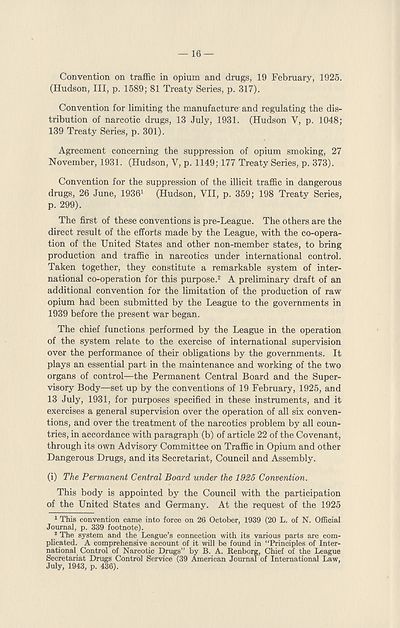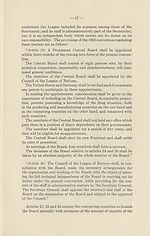Download files
Complete book:
Individual page:
Thumbnail gallery: Grid view | List view

16 —
Convention on traffic in opium and drugs, 19 February, 1925.
(Hudson, III, p. 1589; 81 Treaty Series, p. 317).
Convention for limiting the manufacture and regulating the dis¬
tribution of narcotic drugs, 13 July, 1931. (Hudson V, p. 1048;
139 Treaty Series, p. 301).
Agreement concerning the suppression of opium smoking, 27
November, 1931. (Hudson, V, p. 1149; 177 Treaty Series, p. 373).
Convention for the suppression of the illicit traffic in dangerous
drugs, 26 June, 19361 (Hudson, VII, p. 359; 198 Treaty Series,
p. 299).
The first of these conventions is pre-League. The others are the
direct result of the efforts made by the League, with the co-opera¬
tion of the United States and other non-member states, to bring
production and traffic in narcotics under international control.
Taken together, they constitute a remarkable system of inter¬
national co-operation for this purpose.2 A preliminary draft of an
additional convention for the limitation of the production of raw
opium had been submitted by the League to the governments in
1939 before the present war began.
The chief functions performed by the League in the operation
of the system relate to the exercise of international supervision
over the performance of their obligations by the governments. It
plays an essential part in the maintenance and working of the two
organs of control—the Permanent Central Board and the Super¬
visory Body—set up by the conventions of 19 February, 1925, and
13 July, 1931, for purposes specified in these instruments, and it
exercises a general supervision over the operation of all six conven¬
tions, and over the treatment of the narcotics problem by all coun¬
tries, in accordance with paragraph (b) of article 22 of the Covenant,
through its own Advisory Committee on Traffic in Opium and other
Dangerous Drugs, and its Secretariat, Council and Assembly.
(i) The Permanent Central Board under the 1925 Convention.
This body is appointed by the Council with the participation
of the United States and Germany. At the request of the 1925
1 This convention came into force on 26 October, 1939 (20 L. of N. Official
Journal, p. 339 footnote).
2 The system and the League’s connection with its various parts are com¬
plicated. A comprehensive account of it will be found in “Principles of Inter¬
national Control of Narcotic Drugs” by B. A. Renborg, Chief of the League
Secretariat Drugs Control Service (39 American Journal of International Law,
July, 1943, p. 436).
Convention on traffic in opium and drugs, 19 February, 1925.
(Hudson, III, p. 1589; 81 Treaty Series, p. 317).
Convention for limiting the manufacture and regulating the dis¬
tribution of narcotic drugs, 13 July, 1931. (Hudson V, p. 1048;
139 Treaty Series, p. 301).
Agreement concerning the suppression of opium smoking, 27
November, 1931. (Hudson, V, p. 1149; 177 Treaty Series, p. 373).
Convention for the suppression of the illicit traffic in dangerous
drugs, 26 June, 19361 (Hudson, VII, p. 359; 198 Treaty Series,
p. 299).
The first of these conventions is pre-League. The others are the
direct result of the efforts made by the League, with the co-opera¬
tion of the United States and other non-member states, to bring
production and traffic in narcotics under international control.
Taken together, they constitute a remarkable system of inter¬
national co-operation for this purpose.2 A preliminary draft of an
additional convention for the limitation of the production of raw
opium had been submitted by the League to the governments in
1939 before the present war began.
The chief functions performed by the League in the operation
of the system relate to the exercise of international supervision
over the performance of their obligations by the governments. It
plays an essential part in the maintenance and working of the two
organs of control—the Permanent Central Board and the Super¬
visory Body—set up by the conventions of 19 February, 1925, and
13 July, 1931, for purposes specified in these instruments, and it
exercises a general supervision over the operation of all six conven¬
tions, and over the treatment of the narcotics problem by all coun¬
tries, in accordance with paragraph (b) of article 22 of the Covenant,
through its own Advisory Committee on Traffic in Opium and other
Dangerous Drugs, and its Secretariat, Council and Assembly.
(i) The Permanent Central Board under the 1925 Convention.
This body is appointed by the Council with the participation
of the United States and Germany. At the request of the 1925
1 This convention came into force on 26 October, 1939 (20 L. of N. Official
Journal, p. 339 footnote).
2 The system and the League’s connection with its various parts are com¬
plicated. A comprehensive account of it will be found in “Principles of Inter¬
national Control of Narcotic Drugs” by B. A. Renborg, Chief of the League
Secretariat Drugs Control Service (39 American Journal of International Law,
July, 1943, p. 436).
Set display mode to:
![]() Universal Viewer |
Universal Viewer | ![]() Mirador |
Large image | Transcription
Mirador |
Large image | Transcription
Images and transcriptions on this page, including medium image downloads, may be used under the Creative Commons Attribution 4.0 International Licence unless otherwise stated. ![]()
| League of Nations > Legal > Powers and duties attributed to the League of Nations by international treaties > (18) |
|---|
| Permanent URL | https://digital.nls.uk/191396443 |
|---|
| Shelfmark | LN.V |
|---|
| Description | Over 1,200 documents from the non-political organs of the League of Nations that dealt with health, disarmament, economic and financial matters for the duration of the League (1919-1945). Also online are statistical bulletins, essential facts, and an overview of the League by the first Secretary General, Sir Eric Drummond. These items are part of the Official Publications collection at the National Library of Scotland. |
|---|---|
| Additional NLS resources: |
|

